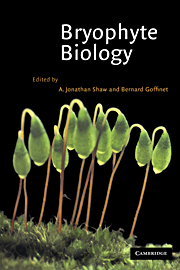Book contents
- Frontmatter
- Contents
- List of contributors
- Preface
- 1 Anatomy, development, and classification of hornworts
- 2 Morphology and classification of the Marchantiophyta
- 3 Morphology and classification of mosses
- 4 Origin and phylogenetic relationships of bryophytes
- 5 Chemical constituents and biochemistry
- 6 Molecular genetic studies of moss species
- 7 Control of morphogenesis in bryophytes
- 8 Physiological ecology
- 9 Mineral nutrition, substratum ecology, and pollution
- 10 Peatlands: ecosystems dominated by bryophytes
- 11 Role of bryophyte-dominated ecosystems in the global carbon budget
- 12 Population ecology, population genetics, and microevolution
- 13 Bryogeography and conservation of bryophytes
- Index
9 - Mineral nutrition, substratum ecology, and pollution
Published online by Cambridge University Press: 05 June 2012
- Frontmatter
- Contents
- List of contributors
- Preface
- 1 Anatomy, development, and classification of hornworts
- 2 Morphology and classification of the Marchantiophyta
- 3 Morphology and classification of mosses
- 4 Origin and phylogenetic relationships of bryophytes
- 5 Chemical constituents and biochemistry
- 6 Molecular genetic studies of moss species
- 7 Control of morphogenesis in bryophytes
- 8 Physiological ecology
- 9 Mineral nutrition, substratum ecology, and pollution
- 10 Peatlands: ecosystems dominated by bryophytes
- 11 Role of bryophyte-dominated ecosystems in the global carbon budget
- 12 Population ecology, population genetics, and microevolution
- 13 Bryogeography and conservation of bryophytes
- Index
Summary
Introduction
Bryophytes are familiar and attractive ingredients in many types of natural landscape. Their shaggy coverings on branches and boughs, crags and boulders, in waterfalls and on woodland banks, add distinction to the larger scene. Less appealingly, they grow occasionally on bizarre materials, like the leather of a discarded boot, or a rusty iron pipe. Even in modern cities where air pollution and the built environment may seem unrelenting, there are bryophytes able to colonize crevices in masonry, soil accumulations in gutters, and to soften the otherwise geometrical wildernesses of roof tiles with their rounded cushions. To the scientist all these situations provide taxing problems concerning the supply of necessary resources, the impact of the bryophytes on their habitat, and their responses to undesirable chemicals in the environment. This chapter describes the special problems that bryophytes encounter in obtaining essential mineral nutrients, and in dealing with non-essential elements and compounds. The substratumt on which a bryophyte grows can be a source of nutrients and of other chemicals that may cause stresses. Also, the periods of time for which different types of substrata are available for colonization by bryophytes vary enormously. Therefore, both the chemical properties and the wider ecological characteristics of different substrata are considered from the point of view of their suitability for bryophyte growth. Many examples of bryophytes behaving as specific indicators of particular chemical environments are given. Their uses in biomonitoring provide practical instances of this.
- Type
- Chapter
- Information
- Bryophyte Biology , pp. 248 - 311Publisher: Cambridge University PressPrint publication year: 2000
- 42
- Cited by



